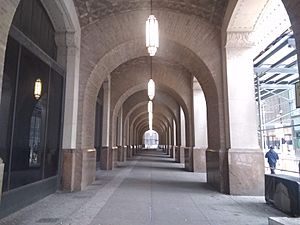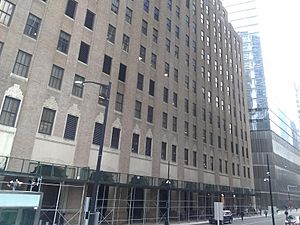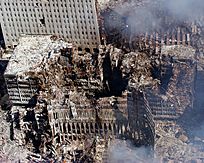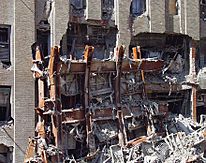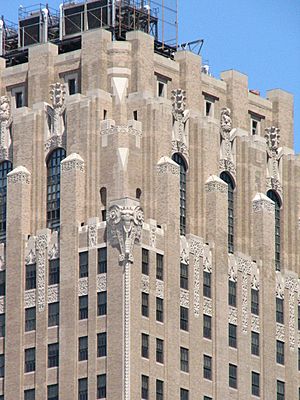Verizon Building facts for kids
|
Barclay-Vesey Building
New York Telephone Co. Building |
|

Western facade in 2013
|
|
| Location | 140 West Street Manhattan, New York |
|---|---|
| Area | 0.9 acres (0.36 ha) |
| Built | 1923–1927 |
| Architect | Ralph Walker |
| Architectural style | Art Deco |
| NRHP reference No. | 09000257 |
Quick facts for kids Significant dates |
|
| Added to NRHP | April 30, 2009 |
The Verizon Building (also known as 100 Barclay, the Barclay–Vesey Building, and the New York Telephone Company Building) is an office and residential building at 140 West Street in Lower Manhattan, New York City. The 32-story building was designed in the Art Deco style by Ralph Walker of Voorhees, Gmelin and Walker, and was Walker's first major commission as well as one of the first Art Deco skyscrapers. It occupies the entire block bounded by West Street to the west, Barclay Street to the north, Vesey Street to the south, and Washington Street to the east, abutting the World Trade Center.
The Verizon Building was constructed from 1923 to 1927 as the Barclay–Vesey Building. It served as the longtime corporate headquarters of New York Telephone and its successor Verizon Communications. The building, being adjacent to the original World Trade Center to the south and 7 World Trade Center to the east, experienced major damage in the September 11 attacks following the collapse of the World Trade Center. Restoration of the building and damaged communications infrastructure after the attacks took three years and cost $1.4 billion. Part of the building was converted into 100 Barclay, a residential condominium development, in 2016.
The Verizon Building was built to have an imposing form, with vertical piers designed as buttresses; setbacks at upper floors; and a program of elaborate ornamentation on the exterior and interior. The Verizon Building's design has been widely praised by architectural critics, both for its design scheme and for its symbolism. The building was added to the National Register of Historic Places in 2009, and its exterior and first-floor interior were declared city landmarks by the New York City Landmarks Preservation Commission in 1991.
Contents
Site
The Verizon Building is on the border of Lower Manhattan's Financial District and Tribeca neighborhoods. It occupies an entire city block bounded by West Street to the west, Vesey Street and the World Trade Center to the south, Washington Street to the east, and Barclay Street to the north. Adjacent buildings include 7 World Trade Center to the east and One World Trade Center to the south. The block is parallelogram-shaped, measuring about 210 feet (64 m) along West and Washington Streets, 250 feet (76 m) along Vesey and Barclay Streets. The total area of the block is 52,000 square feet (4,800 m2).
Prior to the 19th century, the Verizon Building's site was located off the shore of the North River (now Hudson River), but the shore from Vesey Street north to King Street was infilled during the mid-19th century, and docks were constructed west of West Street. A wholesale market called the Washington Market was established on the future Verizon Building block in 1812 or 1813. To support the market and the nearby food businesses, about 35 three- to five-story brick structures were erected on the block. By the time the Verizon Building was erected, the site was located along the shoreline of the Hudson River. In the 1970s, Battery Park City was built on filled land along the shore, severing the Verizon Building from the waterfront.
Design

The Verizon Building, also known as the Barclay–Vesey Building, was designed by Ralph Thomas Walker in the Art Deco style, although it was described at the time of its completion as being "Modernistic" or "Modern Perpendicular". The Verizon Building measures 498 feet (152 m) tall and contains 32 stories, with mezzanines above the ground, 17th, and 31st stories. The Verizon Building is regarded by architectural critics as being the first Art Deco skyscraper. It was also the first major structure that Walker designed for McKenzie, Voorhees & Gmelin, and as such, was aesthetically distinguished from the firm's previous commissions.
Walker intended the Barclay–Vesey Building to be "as modern as the telephone activity it houses". His design took several elements from Eliel Saarinen's proposal for Chicago's Tribune Tower, as well as from Walker's own entry in the design competition for the Tribune Tower. Such elements included the Verizon Building's setbacks; its vertical piers; and its pyramidal roof, which had been a defining feature of Walker's Tribune Tower proposal. The Verizon Building's architecture has been compared to San Antonio's Milam Building, the largest pre-stressed concrete and brick office building and the first to have an integrated designed-in air conditioning system. Walker subsequently designed other Art Deco buildings in the New York City area, such as the New Jersey Bell Headquarters Building (1929), 60 Hudson Street (1930), 1 Wall Street (1931), and 32 Avenue of the Americas (1932), as well as telephone buildings in Upstate New York.
Form
The massing of the Verizon Building includes numerous setbacks. Though setbacks in New York City skyscrapers were mandated by the 1916 Zoning Resolution in order to allow light and air to reach the streets below, they later became a defining feature of the Art Deco style. The lowest ten floors of the Verizon Building occupy the entire area of the city block. Above the 10th floor, there are setbacks on the north and south facades, as well as narrow and deep light courts to the west and east, creating an "H"-shaped floor plan from the 11th to the 17th floors. There are smaller setbacks at each corner on the 13th floor. The building rises as a 108-by-116-foot (33 by 35 m) tower above the 17th floor, though smaller wings flank the tower's northern and southern facades on the 18th and 19th floors. The rectangular tower is aligned with buildings on Broadway to the east, and so is parallel to Barclay and Vesey Streets.
During the design process, Walker had considered plans for "a series of stacked blocks connected by blunt transitions", though this proposal lacked a unified sense of character. The appearance of unity was later attained through the inclusion of piers on the facade.
The Verizon Building's form was also influenced by its interior use. There were numerous functions that did not necessitate sunlight and could operate using artificial light, such as the central operating system and the mechanical space, which was placed inside the building's core. The mechanical core was an important consideration since, at the time, office buildings largely relied on natural ventilation through means such as light courts. Because the office space was placed on the exterior walls, the lowest ten stories did not need light courts. Also as a result, the base could occupy the entire lot area, with setbacks located on higher levels than in other office buildings.
Facade
Walker was inspired by Maya architecture in designing the facade. Above the granite base, the exterior is clad with brick in hues of green, gold, and buff, a material that Walker preferred for its texture and color. There is cast-stone ornamentation on the building's upper floors, as well as patterned motifs and limestone decoration on the lower floors; when possible, these features were created using the help of machines. The Verizon Building also contains serrated stone-and-light-brick parapets, which, when combined with the building's vertical piers, give a naturalistic "alpine" look to the setbacks. When taken as a whole, the materials of the facade were intended to give an impression of stability and mass. The facade also serves a protective purpose: the steel frame is enclosed within 12-inch-thick (30 cm), heavy masonry in the exterior infill walls. The western and eastern facades of the Verizon Building consist of 19 vertical bays, and the northern and southern facades contain 23 bays.
Walker sought to incorporate a program of ornament to attract the interests of passersby and to temper the building's large mass. For the Barclay–Vesey Building, Walker eschewed traditional motifs, such as egg-and-dart patterns, which he saw as clichéd. He wrote that the decorative elements should be "so complicated in its structure as not to be readily comprehended; its framework should be as hidden as the steel structure itself." The ornamental program on the facade was carried out by Ulysses Ricci and John De Cesare. It includes complex foliage; babies and animal heads; and a bell above the door, symbolizing the telephone company. Though Walker characterized the ornamental program as "free and flowing", it was actually rigid and complex. Architectural critic Lewis Mumford stated that the ornamental program at ground level was so extensive that it was "a rock garden".
Ground story
The main facades are on West and Washington Streets to the west and east, respectively. At the center of each side, there are large entrance portals that are three bays wide and two stories tall. These portals contain bronze-framed doorways with decorative motifs. Above the doors are bronze screens with vine-and-grape ornamentation; these formerly also contained motifs of bells to represent the New York Telephone Company. The main entrance portals are framed with a decorative limestone lintel depicting a bird and human figures. The limestone friezes above each set of doors depict a bell flanked by a Mongolian and a Native American, which respectively symbolize the Eastern world and the Western world. On the West Street facade, the main entrance portal is flanked on either side by two single-width double-height bays, a triple-width double-height bay, and another single-width double-height bay. These double-height bays contain storefronts. From top to bottom, the storefronts at the base are generally composed of a solid panel, glazed glass, and a decorative transom.
There is an enclosed, arched arcade above the Vesey Street sidewalk on the southern facade, measuring 252 feet (77 m) long by 16 feet (4.9 m) wide and 19 feet (5.8 m) tall. There are 12 arches in total; each corresponds to two window bays above, except the westernmost arch, which corresponds to one window bay. The arches are supported by brick piers while the ceilings are composed of Guastavino tiles. The arcade was a compromise design because the city wanted to expand the street during the building's construction, while Walker wanted a larger base. The arcade was called "one of the most comfortable shopping fronts in New York City" when the Barclay–Vesey Building was completed, but because it was so dark, the arcade did not receive too much pedestrian traffic. Nevertheless, numerous enterprises were located in the arcade, including a circulating library. The Vesey Street storefronts were converted to office space by the 2000s.
The north facade also contains storefronts set within double-width, double-height arches. Two of the central arches were converted into rectangular garage openings.
Upper stories
On the second through 32nd stories, the window design is mostly consistent. Most window openings contain three-over-three sash windows, though some openings have been covered with louvered grates, especially in places where there are mechanical or communications equipment. The second-story windows are generally topped by elaborate triangular limestone surrounds that contain carvings of birds, grapes, and vines, except at the corners of the building, where the second-story windows contain lintels and sills with carvings of grapes and vines. The third-story windows also contain sills with grape and vine carvings. The fourth- through 32nd-story windows have plain, undecorated sills and windows. Each window bay is separated by vertical limestone piers.
Cast-stone decorative elements are concentrated above the 20th story. For example, at the 29th story, the corner piers contain elephant heads with geometrically-shaped ears and trunks. The 30th floor, 31st floor, and 31st-floor mezzanine contains five triple-height arched windows on each facade. Stone piers protrude above the rooftop level, which contains some mechanical equipment.
Interior
In his design for the Verizon Building, Walker believed that the structure should serve "as a machine which had definite functions to perform for the benefit of its occupants." The design scheme for the interior is a continuation of that on the facade, which was a relatively rare stylistic choice of the time, since many contemporary buildings were being designed with modern-styled exteriors and historically-styled interiors. Mumford likened this continuity in interior and exterior design to the works of Frank Lloyd Wright, Henry Hobson Richardson, and Louis Sullivan, which also exhibited such consistency. As with the exterior, there is masonry encasing interior structures. Brick, cinder, concrete, and other masonry materials encase interior steel columns, beams, girders, and other structural elements. Walker also created the interior elements by machine when it was possible.
The interior space covers 1.2 million sq ft (110,000 m2). The structure was split into two different mechanical sections: the 18th through 32nd floors, and the basements through the 16th floor. The 17th floor housed the mechanical equipment, which was unusual since other buildings' mechanical equipment were usually contained on their roofs or in their basements. There are 26 elevators to transport tenants to upper floors. The second through 16th floors are served by two elevator lobbies, while the 18th through 32nd floors are served by a single elevator lobby.
Lobby
The lobby runs between the West and Washington Street entrances to the west and east, with a 22-foot-high (6.7 m) vaulted ceiling. The interior of the lobby includes buff-colored veined marble walls and floors. Toward the center of the lobby, there are two alcoves each on the north and south walls, which lead to the elevator banks. The northern alcoves both contain eight elevators while the southern alcoves both contain four elevators. All of the elevator alcoves contain painted ceilings and ornate bronze fixtures for ventilation and lights. A telephone alcove is also located off the lobby. Since the upper floors' residential overhaul in the 2010s, the western half of the lobby is still used by Verizon, but the eastern half is used as a residents' lounge.
The decoration program of the lobby is also in the Art Deco style. These works were designed by Ricci and De Cesare, and executed by Edgar Williams and Mack, Jenney & Tyler. The elevator doors are framed by bronze surrounds, while the elevator lobbies feature Levanto marble walls. Other doorways leading from the lobby, as well as the fluted pilasters along the lobby's length, are also made of Levanto marble. The doors from the lobby are made of bronze, as are the capitals of the pilasters, which incorporate grape-and-vine motifs.
The lobby features inlaid bronze medallions in the floor, which depict the construction of the telephone system. The medallion on the eastern side depicts a female telephone operator, and that on the western side depicts a lineworker. There are twelve ceiling murals that depict how human communication has progressed, from Aztec runners to the telephone. Nine murals—five at the western entrance and four at the eastern entrance—demonstrate the ancient methods of communication. The three center murals depict modern communication. Bronze chandeliers with complex ornamentation hang from the ceiling over the bronze medallions on the floor. On the ceiling are "angelic figures", which appear to be holding the chandeliers.
Other floors
The lowest ten floors above the basements were intended for use as office space serving the central telephone offices, and could handle live structural loads of up to 150 or 275 pounds per square foot (730 or 1,340 kg/m2), depending on the intended uses of each floor section. The 29th floor included New York Telephone's offices, and the 31st floor contained an assembly room that could hold 6,500 workers. When the Barclay–Vesey Building opened, it contained an auditorium at ground level and a gymnasium at the ground-floor mezzanine. There was also a training school for workers.
The stories above the 10th floor have been converted into 157 luxury condominium units. There is a separate lobby for residents on the Barclay Street side, which connects to the original lobby. The penthouse apartment, a duplex unit on the 31st and 32nd floors, covers 14,500 square feet (1,350 m2) with a 96-by-33-foot (29 by 10 m) living room, advertised as the largest in the city. The building also contains an 82-foot-long (25 m) wading pool and a 300-foot (91 m) lap pool. Other features of the residential portion of the Verizon Building include rooms for wine-tasting and billiards; music practice; a fitness center; a children's playroom; and a residents' lounge.
The Verizon Building has five sub-basement levels, which house communications equipment. At the time of the September 11 attacks, Verizon was using the building as a main telecommunications switching center in Lower Manhattan, handling approximately 200,000 phone lines and 3.6 million data circuits. These circuits traveled as far north as 42nd Street. In emergencies, the 17th floor could provide services to the building's base. As built, the Barclay–Vesey Building contained a cafeteria and recreation rooms within one of its basements. These spaces contained trees and paintings, and one wall contained a mural depicting a panoramic view of the Mediterranean from Spain.
History
Planning and construction
Planning
The New York Telephone Company began to grow rapidly after World War I. An internal review of the organizational structure found that its New York City operations were housed in multiple buildings across the city, and were thus inefficient. The company's president from 1919 to 1924, Howard Ford Thurber, sought to centralize the company's operations into a single large headquarters to "satisfy the present demands and to reasonably anticipate future requirements". In the early 1920s, the New York Telephone Company started acquiring the entire block between West, Barclay, Washington, and Vesey Streets. The site was chosen "because real estate values in that vicinity were much lower" compared to the area around Broadway, being relatively isolated from the rest of the neighborhood. The company owned the entire block by 1923, by which it had spent $1.5 million on acquisitions.
In April 1923, the company announced that it intended to build a new headquarters at a projected cost of $11.5 million. The structure was to house 6,000 employees from the company's six central offices, who would work with 120,000 telephones, as well as mechanical equipment to support the company's equipment. The initial design called for a height of 404 feet (123 m), with 680,000 square feet (63,000 m2) of office space, and 38,000 square feet (3,500 m2) of commercial ground-floor storefronts. In addition, the building would be erected with a steel-and-concrete frame, as well as facade trim made of limestone and buff-colored brick. The building was to be designed by Ralph Walker of Kenzie, Voorhees & Gmelin, who was then thirty-four years old and relatively inexperienced. At the time, construction was expected to be completed in July 1925.
It is likely that Walker started planning the Barclay–Vesey Building in late 1922, while he was still designing the Tribune Building. Walker wished to create a "strong corporate image" for the structure. He further sought to ensure that the proposed headquarters would comply with the 1916 Zoning Resolution while also being spacious and relatively inexpensive. Accordingly, Walker created designs for buildings containing 10, 16, 26, 29, 32, 36, and 42 floors. Walker also tested out different architectural styles, such as the Gothic and Italian Renaissance styles, before settling on a "modernistic" Art Deco style. The 32-story proposal, with setbacks at the 10th, 13th, 17th, and 19th floors, was ultimately deemed the most efficient. The blueprints for the 32-story proposal were submitted to the New York City Department of Buildings in June 1923.
Construction
Foundation work began on June 20, 1923, and since the site was mostly artificial fill with riprap buttressing, water from the Hudson River sometimes leaked through to the foundation. The building's foundation needed to descend to the level of the bedrock, and the earth was described as having a slimy consistency below water level. Since the bedrock was deeper than originally anticipated, this allowed the builders to include five basement levels, rather than four. To keep out the water and slime-like earth, the builders erected a cofferdam with 22 caissons. The builders then laid down permanent steel struts to hold back the cofferdam. Not only was this likely the first such use of steel bracing, it saved $30,000 compared to the temporary wood bracing that had been used in previous projects.
During construction, almost 700 workers were employed for the project at any given time; tradesmen, such as plumbers and electricians, worked with concrete and steel contractors in overlapping shifts, in order to reduce delays. The superstructure incorporated 20,000 short tons (18,000 long tons; 18,000 t) of steel across its above-ground and below-ground sections, and the builders used six derricks to lift the girders from the street. Four temporary stairways, each containing 351 steps, were built to facilitate the construction of the upper floors. The floor arches were built starting in October 1924, and on average, one floor was completed per week. New York Telephone's vice president James S. McCulloh placed both the first and the last rivets.
The first employees moved to the Barclay–Vesey Building on February 19, 1926. All construction on the Barclay–Vesey Building was completed by June 1926. However, the New York City Department of Buildings did not declare the building to be completed until April 1927.
20th-century use
New York Telephone originally had four dial telephone exchanges at the Barclay–Vesey Building. Two additional exchanges were activated in 1928, which would be able to serve 125,000 additional subscribers; at the time, Lower Manhattan was one of the busiest telephone districts in the world. During the mid-20th century, office space was gradually removed to make room for additional equipment.
In 1970, the company signed an agreement to move its executive offices to 1095 Avenue of the Americas, a proposed 53-story speculative development near Bryant Park in Midtown Manhattan, which would be larger than the existing West Street offices. Two years later, the New York Telephone offices had moved out of the Barclay–Vesey Building, though the switching offices remained. When NYNEX was formed as a result of the breakup of the original AT&T in 1984, the building became NYNEX's headquarters. Improvements in technology resulted in the invention of smaller telephone equipment, leading to an increase in available office space at the Barclay–Vesey Building. By the 1990s, some office workers were moving back into the Barclay–Vesey Building.
The exteriors and ground-floor lobbies of the Barclay–Vesey Building and two other telecommunications buildings were designated city landmarks by the New York City Landmarks Preservation Commission in 1991. New York Telephone supported the designation, and the company's own media had previously described the building as a "landmark". The Barclay–Vesey Building became the headquarters of Bell Atlantic following Bell Atlantic's 1997 merger with NYNEX. Subsequently, in 2000, the building became Verizon Communications' headquarters after Verizon was formed from the merger of Bell Atlantic and GTE.
21st-century use
Damage and restoration
At the time of the September 11, 2001 attacks, the Verizon Building was being renovated. The Verizon Building had been adjacent to 7 World Trade Center to the east and the World Trade Center's Twin Towers to the south, and when the three buildings collapsed during the attacks, the south and east facades were severely damaged by falling steel beams. The collapse of the World Trade Center causing partial collapses on some floor slabs close to the windows, though the building as a whole was not in immediate danger of collapse. Debris also sliced water mains, flooding the basements. As a result, underground cable vaults belonging to Verizon, along with other underground utility infrastructure, were heavily damaged from water and debris. The Verizon Building received only moderate damage because its thick-masonry design gave the building added strength. The masonry allowed the structure to absorb much of the energy from debris hitting the building, and damage was restricted mostly to impact points. Although no fires were observed in the Verizon Building, the ground-floor murals were damaged by smoke.
Tishman Realty & Construction, which had been planning work on the building prior to the attacks, did a quick assessment of the building in the days after the attack. William F. Collins AIA Architects was the lead architectural firm working on the restoration, while Tishman Interiors managed the project. The Excalibur Bronze Foundry and Petrillo Stone were hired as specialists to restore the intricate ornamental detail in the facade and in the lobby. Facade restoration involved carving motif designs in the ornamental limestone, and restoring the ceiling murals in the lobby. For the murals in the lobby, hypodermic needles were used to inject acrylic resin to restore the paint and plaster. On the executive office floors, workers restored the barrel-vaulted ceilings, plaster friezes, and other elements. Restoration of the building also involved replacing a corner column; A+ Construction of Rye, New York was responsible for this work. The building's 23 elevators were also upgraded, new fire alarms, building command systems, and chillers installed, and restrooms made accessible to those with disabilities.
Restoration of the building took three years, at a cost of $1.4 billion. The New York Times stated that the project would cost "three-quarters of the Chrysler Building's estimated total value." Throughout the restoration, the building continued to serve as a telephone switching center. In 2004, the New York Landmarks Conservancy awarded Tishman Interiors the Lucy G. Moses Preservation Award for its restoration work on the Verizon Building. The restoration was complete by late 2005. That December, Verizon announced it would move its offices from 1095 Avenue of the Americas to 140 West Street, where there would be space for 1,500 employees; the operations hub was relocated to Verizon's campus in Basking Ridge, New Jersey. The Verizon Building was added to the National Register of Historic Places in 2009.
Partial sale and residential conversion
The building was partially flooded by storm surges from Hurricane Sandy in 2012, which seeped into the basement levels, took all except one of the elevators out of service, and damaged the lobby murals. The next year, Verizon sold off the top floors to developer Ben Shaoul, the head of Magnum Real Estate. Verizon retained the 28th and 29th floors as well as the ground through 10th stories. In conjunction with this sale, Verizon moved 1,100 employees to Downtown Brooklyn and relocated others to 1095 Avenue of the Americas. To prevent against future flood damage, Verizon installed a storm surge barrier in front of the building.
Following Verizon's sale of the top floors, it was announced that Magnum Real Estate would convert the upper floors to a condominium complex known as 100 Barclay. Shaoul and the CIM Group added 157 units to the Verizon Building, and the condos were first listed for sale in early 2016. However, 100 Barclay's residential units remained largely unoccupied by 2019, leading Magnum Real Estate to reduce the penthouse's asking price from $59 million to $39 million. To fill up the unused units, Magnum Real Estate also started advertising to renters.
See also
 In Spanish: Verizon Building para niños
In Spanish: Verizon Building para niños



